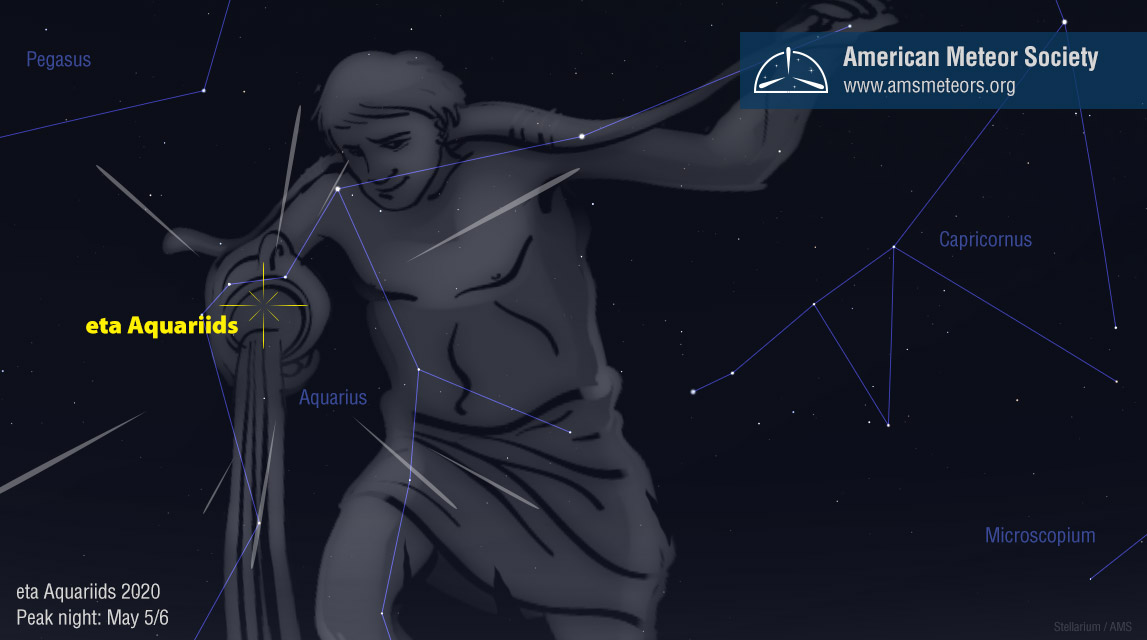Halley’s Comet particles
Many of our readers were born after the last appearance of Halley’s comet in 1986. They will have to wait until 2061 for it’s next appearance. For those of us who did see it 34 years ago, most of us will not be around for it’s return in 2061. We can all take solace in the fact that remnants from Halley’s comet are circling the solar system, often far from the comet, and encounter the Earth twice each year in the form of meteors from the eta Aquariids of May and the Orionids of October. So while we cannot view the comet itself, we can see bits of ice and dust it has left behind over the past few millennia.
The Orionids are the inbound particles of Halley’s comet while the eta Aquariids are the outbound particles. It should be noted that the particles we see as meteors separated from the comet many hundreds of years ago as the current orbit of the comet does not cross the orbit of the Earth.
eta Aquariids 2020 will peak on May 5/6
Since the eta Aquariids are the outbound particles of the Halley’s comet, we see them to the west of the sun from April 17-May 24 each year. This positioning only allows these meteors to be seen on the morning side of Earth. To make matters more restrictive, the source of these meteors, located in the constellation of Aquarius, does not clear the horizon until 2:00 to 3:00am local daylight saving time. Viewing circumstances for the eta Aquariids are best for those located in the southern tropics where the source of these meteors rises highest in a dark sky. This window of opportunity to view these meteors in a dark sky shrinks as one moves north until one reaches latitude 60°N. At that point the source rises at the same time as dawn breaks, therefore no activity can be seen. Most observers in the northern hemisphere have a two hour window prior to dawn to view these meteors.
In 2019, the new moon coincided with the shower’s maximum and hourly rates as high as 39 as seen from Australia. Unfortunately this year the moon will be full on May 7, compromising observations near maximum activity (May 5 & 6). Currently the moon is a waxing gibbous that sets during the early morning hours. The potential observer has the chance to view increasing eta Aquariid activity by viewing when the moon is low in the sky up until the first light of dawn begins to interfere. Activity from this shower will increase nightly and peak on May 5 and 6. After maximum, rates will slowly diminish until no activity appears at all around May 24. Also after maximum, the moon will remain in the sky all morning long further impeding observations.

To best view these meteors, look toward the eastern half of the sky during the last couple of hours prior to dawn. This will keep the moon at your back if it is still above the horizon. Find yourself a comfortable lounge chair and use it to center your view half-way up in the eastern sky. You will see eta Aquariid meteors shooting upward from the eastern horizon. These meteors are striking the Earth from a head-on position so they will be swift, often covering several tens of degrees in a split second. They may appear in any portion of the sky but will all trace back to their source in Aquarius. There will be other meteors visible too, some from minor showers and most from random activity. These meteors will most likely be slower than the eta Aquariids.
Hourly observations are accepted by the International Meteor Organization. Simply register (it’s free) or log in at www.imo.net and enter your data on their visual meteor observing form. We ask for sessions of at least an hour long due to the fact that meteor activity is notoriously clumpy. This means you may see no activity for 10-15 minutes and then a many meteors within a few minutes. If you limit you watch to less than an hour, you may witness one of those short lulls and be dissatisfied with your results.
This is your last chance to see amplified meteor activity until late July so if your skies are clear during the next few mornings, I encourage you to take advantage of the chance to see bits of Halley’




 You saw something bright and fast? Like a huge shooting star? Report it: it may be a fireball.
You saw something bright and fast? Like a huge shooting star? Report it: it may be a fireball.  You counted meteors last night? Share your results with us!
You counted meteors last night? Share your results with us!  You took a photo of a meteor or fireball? You have a screenshot of your cam? Share it with us!
You took a photo of a meteor or fireball? You have a screenshot of your cam? Share it with us!  You caught a meteor or fireball on video? Share your video with us!
You caught a meteor or fireball on video? Share your video with us!
2 comments
What’s the time I should observe?
Kulanitha and All,
To see any eta Aquariid activity one should watch during the last two hours prior to dawn.